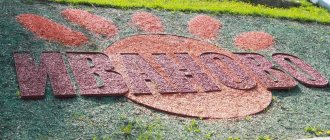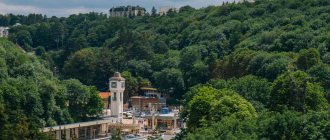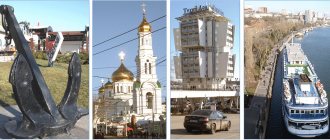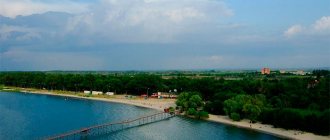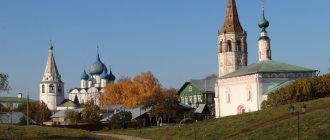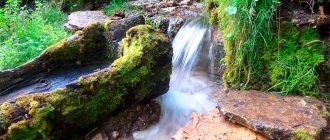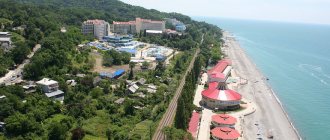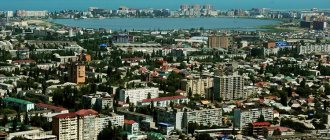| First day Second day Museums of Vologda in 2 days Stories, routes and tips from tourists with photos Where to stay in Vologda Excursions from Vologda for 2 days |
Vologda is a popular weekend destination. The city is accessible by transport and is famous for its abundance of architectural monuments. Thanks to the ancient wooden houses and stone mansions in the historical center of Vologda, the city seems frozen in time. Here you want to take a leisurely walk, and not rush to see all the sights. Therefore, 2 days is the ideal period for traveling to Vologda.
A Vologda itinerary for 2 days can include visits to top tourist sites, visits to museums, and walks along ancient streets. Depending on the time of year, you can also add a holiday on the Vologda River and trips to the suburbs to your route. How can you see all the sights of Vologda in 2 days and not miss anything? Make a list of objects that interest you in advance.
View of the center of Vologda from the river Photo: © dualia1
First day
The first day should be devoted to the main attractions of the city, located on the right bank of the Vologda River. These are the historical districts of Verkhniy Posad, Gorod and Vologda Sloboda. The historical center of the city is small in area; the route can be covered in one day on foot at a leisurely pace.
The route begins in the Verkhny Posad area. Here you will see ancient churches built from different centuries. The first on the route will be the Assumption Cathedral , built at the end of the 17th century. Despite the fact that the cathedral is the architectural dominant of the Gorne-Uspensky Monastery , the temple looks quite simple. The Assumption Cathedral was built in the traditions of Russian architecture of the 16th century - with a minimum of decorative elements on the facade. During the Soviet period, the cathedral was closed - film shows were held inside. But now the Gorne-Uspensky Monastery is operational again.
Moving to the next church, the Temple of Constantine and Helena , it is worth stopping on the river bank in a place called Lazy Platform . This place many centuries ago was the historical center of the Vologda settlement. The last historical buildings were destroyed during the Soviet period. Nowadays there is a monument “800 years of Vologda” , erected in 1959. The Church of Constantine and Helen is considered one of the most beautiful in the city - unlike many other ascetically designed facades of churches in the Russian North, the facade of the Church of Constantine and Helen is made in the Russian patterned style.
Details: Church of Constantine and Helena
Church of Constantine and Helena Photo: © Ena
After admiring the wooden houses with the famous carved palisades, known from the Soviet song (the main part of the wooden buildings are located in the blocks between Mayakovsky Street and Pobeda Avenue), examine the ensemble of churches of the Ilyinsky parish and go to the embankment of the Vologda River . Here you can relax in the Kremlin Garden , have a snack and take funny photos with the sculptures. Further along the route is the main attraction of Vologda, the Kremlin.
Photo: © Igor Butyrskii
The Vologda Kremlin was founded during the reign of Ivan the Terrible, by order of the Tsar. It was built as a defensive structure, but several centuries later it lost its military-strategic purpose - the walls and towers were dismantled. The Bishop's Court , the residence of the Vologda bishops, located outside the Kremlin walls, as well as several churches, have survived to this day
The most outstanding building of the Vologda Kremlin is considered to be the St. Sophia Cathedral , built under Ivan the Terrible. Inside the cathedral, frescoes from the 17th century and a baroque iconostasis from the mid-18th century have been preserved. In good weather, it is worth climbing the bell tower of the St. Sophia Cathedral - it offers a panoramic view of the historical part of the city and the opposite bank of the Vologda River.
More details: Vologda Kremlin
Bell tower of St. Sophia Cathedral Photo: © Igor Butyrskii
It is worth allotting 2–2.5 hours to visit the Kremlin and inspect the museum exhibitions. Next, go to Vologda Sloboda. Along the way, you can see several more churches: the Alexander Nevsky Temple built in the 18th century, the Church of the Intercession of the Blessed Virgin Mary at Torg (XVIII century) and the Church of the Kazan Icon of the Mother of God , founded under Ivan the Terrible. Next, you should visit the city market, where you can buy Vologda products. the Rybnoryadsky Bridge to the other side of the Zolotukha River. Here it is worth taking a walk along Prechistenskaya embankment to the Vologodskaya Sloboda exhibition complex. The route of the first day in Vologda ends at this place.
Detailed route: What to see in Vologda in 1 day
Vologda Kremlin Photo: © dualia1
Theaters
Drama Theater
The oldest regional theater in Vologda has existed since 1849. During this time, he changed several wooden buildings and addresses, while remaining at the epicenter of the city's cultural life. In the year of its 125th anniversary, the theater finally acquired its own home - a minimalist building made of glass and concrete.
The playbill presents plays by classics and modern authors: Gogol, Ostrovsky, Griboedov, Shakespeare, Alexievich, Heifetz and others.
Chamber Drama Theater
st.
Mira, 18 The non-state theater appeared in Vologda only 20 years ago, when the ambitious troupe of the Youth Theater decided to create a new creative association. For a long time, the actors played entertainment in rented venues until they were given their own building.
The chamber theater settled in an old two-story mansion. The poster includes works by domestic and foreign authors in original interpretations. Dramas, comedies and musicals regularly attract full houses.
Puppet theater "Teremok"
st. Lenina, 21
The children's puppet theater was founded in 1937. Recently it has occupied the building of the former church of Zosima and Savvaty Solovetsky. The architectural features of the building with a turret and kokoshniks on the windows are really associated with a fairytale tower - hence the name of the theater.
Performances are designed for audiences from 0 to 16 and older. For the little ones we offer timeless classics: “Thumbelina”, “The Frog Princess”, “Kolobok”. For older viewers and their parents, more serious productions: “Khanuma” by Tsagareli and “As You Like It” by Shakespeare.
Theater for Young Spectators
The Vologda Youth Theater was founded by theatrical standards recently - in 1976. For the first 4 years, the creative team wandered around cultural centers until they got their own premises. The actors were given the building of the Pushkin People's House, which previously housed the drama theater.
The Youth Theater has two halls at its disposal:
- The large one seats 425 spectators. It is equipped with a round rotating platform, a hold and hatches. In addition, there is a huge screen for projecting images.
- The small hall is designed for 88 people. It is used for original productions and chamber performances.
Second day
The second day in Vologda is worth devoting to a visit to the Spaso-Prilutsky Dimitriev Monastery and walks on the left bank of the Vologda River.
Spaso-Prilutsky Dimitriev Monastery
The holy monastery, located on the outskirts of Vologda, in the Priluki microdistrict, was founded in 1371 by a disciple of Sergius of Radonezh - Dimitri Prilutsky. It is from this monastery that one of the masterpieces of Russian icon painting by the Moscow master Dionysius comes - “Reverend Demetrius of Prilutsky, with Life” (late 15th - early 16th centuries). Now the icon is kept in the Vologda Museum-Reserve. The miraculous relics of St. Demetrius of Prilutsky are kept in the monastery itself.
One of the largest and oldest monasteries in the Russian North reached its peak in the 18th century. At that time he was the richest in the region. During the Patriotic War of 1812, church valuables from the holy monasteries of Moscow and the Moscow region were kept in the monastery. During the Soviet period, a transit prison was established on the territory of the Spaso-Prilutsky Dimitriev Monastery - dispossessed people were temporarily kept here before being sent to the northern camps. In the middle of the 20th century, military warehouses, a cinema, and a house for the disabled were located on the monastery square. But already under Soviet rule, a decision was made to restore the buildings and turn the monastery into a museum-reserve. Now the monastery is operational, tourists are allowed into the territory during services and church holidays, as well as as part of an excursion group at other times.
The monastery ensemble is an architectural monument of the 16th–18th centuries. The oldest buildings of the monastery include: the Spassky Cathedral (built 1537–1540), the wooden Assumption Church (the first half of the 16th century, the oldest wooden tent church in Russia), stone monastery cells (early 17th century). Also impressive are the monastery walls with a total length of 950 meters with impressive towers.
Details: Spaso-Prilutsky Dimitriev Monastery
Spaso-Prilutsky Dimitriev Monastery Photo: © dualia1
The second half of the day can be devoted to the sights of the Vologda district of Zarechye, located on the left bank of the river. The district was settled later than the right bank of Vologda. From historical documents it is known that the first wooden houses in the area appeared in the 17th century. But the area began to be actively populated only in the following centuries. A fire in 1920 destroyed most of the ancient wooden buildings of Zarechye - more than 300 houses. In Soviet times, large enterprises appeared here, including the Shipyard. Now the main attractions of the area are the ancient churches located along the 6th Army embankment.
Church of the Presentation of the Lord
The church in the late Baroque style with a bell tower in a pseudo-Gothic style was erected in the 30s of the 18th century. The first church on this site, a wooden one, was located in the middle of the 17th century. In 1735, a warm church was built, 100 years later the ensemble was supplemented with a cold church. The appearance of the church combines the traditions of Baroque, which came late to the Vologda region, and Russian pattern design of the 17th century. Unique architectural details in the external decor of the church are the inserts of glazed figured tiles on the architraves, pediments and pilasters. Previously, the church housed several valuable icons, but now they are exhibited in major Russian museums. The most valuable icon is the “Descent from the Cross” (16th century) - it is kept in the Tretyakov Gallery.
More details: Church of the Presentation of the Lord
Church of the Presentation Photo: © Igor Butyrskii
Church of John Chrysostom
The stone Church of St. John Chrysostom was erected in 1664, but, as is the case with many other churches, a wooden church previously stood on this site. Two churches were combined in one building: cold and warm. In the 17th century, the temple was considered one of the most beautiful in Vologda - many guests of the city described it. But by the 20th century the parish became the smallest, which led to the decision to close it. In the 30s of the 20th century, a military warehouse was located in the temple, but in the 60s the church was recognized as a cultural monument. Now the temple has been returned to the Orthodox community, but is in need of restoration work.
Church of St. John Chrysostom Photo: © Ena
Church of Demetrius of Prilutsky
One of the first stone churches in Vologda was erected in 1651. The complex consists of two churches - the cold five-domed Church of Demetrius of Prilutsky and the warm single-domed Assumption Church with a bell tower. The name of the church often uses the epithet “on the curtain”. This word was used to describe the low bank of the river—the church was located in an area that was flooded by spring floods. The architecture of the Church of Demetrius of Prilutsky is close to the traditions of Yaroslavl architecture of the mid-17th century, while the Assumption Church is reminiscent of ancient Russian churches. It is worth going inside the Church of Demetrius of Prilutsky - 18th-century paintings have been preserved on the walls, and the iconostasis is an example of the Baroque style with elegant and rich carvings.
Details: Church of Demetrius of Prilutsky
Church of Demetrius of Prilutsky Photo: © Ena
Church of St. Nicholas the Wonderworker
The Church of St. Nicholas the Wonderworker was built in 1669 in the Vladychnaya Sloboda area - that was the name of the area belonging to the Bishop's court (that is, the lord). The temple is considered the third oldest - only St. Sophia Cathedral and the Church of Demetrius of Prilutsky are older than it. At the end of the 19th century, St. Nicholas parish was the second largest in the city. The temple was closed only in 1930. Initially, dispossessed residents from the middle and southern regions of the USSR were kept here. Later, a toy factory and a felted goods factory were opened in the church building. Now the temple is operational.
The Church of St. Nicholas the Wonderworker stands out with its large black domes - this is a new building; the previous domes were removed during the Soviet period. The architectural style of the temple is Russian patterned. The interiors were made in the Baroque style: instead of painting, the walls were decorated with rich ornamental molding.
Details: Church of St. Nicholas the Wonderworker
Church of St. Nicholas the Wonderworker Photo: © Ena
Church of St. Andrew the First-Called
The last one on the route is the Church of St. Andrew the First-Called , also located on the embankment, behind the bridge of the 800th anniversary of Vologda. The temple was built in 1670 on the site of a wooden church from the early 17th century. Like some other Vologda churches, in Soviet times, transit “kulaks” were kept here, and then state warehouses. Now the temple has been restored and is operational.
The most striking detail of the Church of St. Andrew the First-Called is one onion dome. According to historical evidence, the temple originally had 5 domes. The temple looks strict and laconic; its ensemble is complemented by a more openwork bell tower.
Panoramic view of the Church of St. Andrew the First-Called
Detailed material: Temples of Vologda
What to see in Vologda in 2 days in summer? In the warmer months, it's worth going on a river cruise. You will again see the sights of Vologda that you saw in 2 days, but from a different angle. In addition, a river walk is a way to relax and enjoy the views of the city and take a break from a busy walk. The most popular route is a 1.5-hour walk from Kremlin Square to the Spaso-Prilutsky Monastery with a guided tour. An alternative option is from the monument to the 800th anniversary of Vologda to - museum of Peter I. During the navigation period, river walks are organized daily, every 1.5–2 hours.
Photo: © dualia1
Saint Sophia Cathedral
Geolocation is the territory of the Vologda Kremlin, so you won’t have to search for the object for long. The main cathedral of the region began to be built in the 10th century. Since then, its shiny gray domes and snow-white walls remain the key symbol of the city. The most famous architectural analogue is the Assumption Church in Moscow. The builders once spent 20 long years doing everything about everything; the first service was held here in 1867.
A quarter of a century later, the holy monastery faced a serious test; the troops of Lithuania and Poland destroyed the complex almost to the ground. Vologda's calling card is lucky. Through the diligent efforts of the craftsmen, the temple was quickly restored and became even more beautiful and majestic. A religious building should be inspected both from the outside and from the inside. The pearl and pride of the building is the “Last Judgment” fresco, recognized as the largest “painting” of a similar theme in the entire Russian state.
And other wall paintings in these walls are worthy of admiration; the time of the last reconstruction was the 60s of the twentieth century. Among the maestros of the brush who had the opportunity to decorate the interior of the cathedral was such an outstanding artist as Maxim the Greek. Services in the institution are now rare, held only in the warm season on special occasions.
Museums of Vologda in 2 days
Museums are another must-see, what to see in Vologda in 2 days. There are more than 10 museums in the city, but most of them have very small exhibitions. The inspection will take no more than 1–1.5 hours. First of all, it is worth visiting museums related to crafts and artistic crafts of the Vologda region.
Lace Museum
The museum is located in a brick building of the 18th century, which previously belonged to the State Bank. More than 500 exhibits of the museum tell about the development of the art of lace making in Vologda; a separate exhibition is dedicated to lace making in the world. Among the exhibits are costumes created specifically for the museum based on ancient designs, as well as decorative items: napkins, tablecloths. The museum hosts master classes on artistic crafts, and there is a store with handmade products from local craftswomen.
More details: Lace Museum
Lace Museum Photo: © dualia1
Center for Folk Crafts "Carved Palisade"
The works of local craftsmen can also be seen at the Carved Palisade Folk Crafts Center . Behind a carved wooden fence, in an openwork wooden house, there are exhibitions dedicated to the crafts of the Vologda land. The interiors of the rooms are created from objects of artistic crafts: carved furniture is covered with Vologda lace, tools of needlewomen and craftsmen are laid out on the table. The folk crafts center hosts temporary exhibitions of local craftsmen and master classes for guests of different ages.
Folk Crafts Center “Carved Palisade” Photo: © Konstantin Pavlov
You can look at the paintings in the Vologda Art Gallery , located in the Resurrection Cathedral. The collection of the art museum is very rich - there are works by many famous artists of the second half of the 19th and early 20th centuries. Near the pedestrian “Red Bridge” there is a gallery of modern art , opened in 2003. On an area of 800 sq.m. paintings of various art movements of the 20th–21st centuries are exhibited: from symbolism and the Soviet avant-garde to the works of contemporary artists. The gallery also hosts temporary exhibitions of paintings, photographs and art objects by Vologda and Russian artists.
St. Sophia and Resurrection Cathedrals Photo: © dualia1
You can learn about the fate of famous personalities exiled to Vologda (among them Joseph Stalin) at the Vologda Exile Museum . There are also several memorial house-museums in the city dedicated to the life and work of natives of the Vologda region and people whose biographies are closely connected with Vologda. These are: the house-museum of Peter I , the apartment-museum of the poet K. N. Batyushkov (Pushkin’s mentor), Shalamovsky house . Several museums in Vologda introduce city guests to the life of past centuries: the Museum of Pharmacy of the Vologda Region , the exhibition complex “Vologda at the turn of the 19th–20th centuries” , “The World of Forgotten Things” .
Detailed material: Museums of Vologda
Museum “World of Forgotten Things” Photo: © Ena
Botanical Garden Botanika
The address of the collection of flora and fauna in the northern regions called Botanika is Orlovsky Lane, 10A. The charming oasis is open for visits on all days of the week; you can choose rooms according to your interests: a greenhouse, an animal area, a butterfly garden, a desert area, a fragment of the natural areas of Australia and other continents. Thematic excursions here are endless; employees are constantly adding new ideas to the list about what else to tell visitors.
Among the latest offerings are interactive events. An exotic garden with a delightful flora is available for colorful photo sessions; newlyweds sometimes rent the botanical property not only for photography as a souvenir of the special day, but also for the wedding party in the bar. The botanical garden often hosts biology classes for students and schoolchildren; adult citizens enjoy attending master classes.
Stories, routes and tips from tourists with photos
Tourists will tell you in their reviews how to get to know Vologda better in 2 days. In their reports, tourists describe their routes around the city and share unusual places. In the reviews you can find tips on organizing leisure time in Vologda, recommendations for cafes and restaurants. You will see photographs of Vologda in winter and summer, and find out what time is best to plan your trip.
- “Vologda in winter 2016” - a story from Yulena Bessonova.
- A series of reports from Irina: “Weekend in Vologda (part one)” and “Weekend in Vologda (part two).”
All tourist reviews about trips to Vologda
See also advice: What to bring from Vologda
Church of Alexander Nevsky Photo: © dualia1
What to see with children in winter
Travelers with children will also find something to do in Vologda in winter. It is convenient to combine sightseeing in Vologda with a walk along the Kremlin Garden or embankments , and ride down the hills. The city has indoor entertainment centers and playrooms, and museum grounds await little guests for interactive excursions and master classes. New Year's dates are especially diverse with a wide variety of events.
New Year is the most anticipated and favorite holiday of the year among children. At the end of December and beginning of January, New Year's fairy tales are always staged on the stages of cultural institutions in Vologda. Look for performances in the posters of the Vologda Drama Theater , Youth Theater , the Teremok Puppet Theater , the Petrushka House Theater , the City Palace of Culture and the Philharmonic . Festive performances often include a round dance around the Christmas tree and an entertainment program.
In the Petrushka theater house Photo: © Irina Porunova
The Vologda Museum of Childhood features ancient Russian and Soviet toys, so it will be no less interesting for adults. On New Year's dates, thematic films and master classes are launched here, for example, on creating a Christmas tree decoration. At the same time, a special excursion is held where guests will learn about the traditions of celebrating the New Year and the main symbols - Grandfather Frost and the Snow Maiden.
A lot of programs are organized by the Vologda Museum-Reserve . On weekends, the whole family can go on many group excursions, films and lectures. Excursions about the ancient northern region and the New Year are designed for children; they usually appear in the institution’s poster during the January holidays. They are also trying to get people interested in the cultural program at the branch of the museum “Literature. Art. Century XX" . Here children will learn about the history of the creation of cartoons and will be able to express themselves in creative activities. Creating your own masterpieces is also part of the Carved Palisade . Parents and children will be introduced to handmade products and invited to make their own. On New Year's dates they have photo zones and photo quests.
Photo: © Irina Porunova
To find out what rituals are associated with the celebration of the New Year in different countries, what kind of Christmas tree there is and how it is decorated, it is worth visiting the Vologda Botanical Garden . Usually he also develops game programs for the holidays, they include animation and master classes for the whole family. In addition, a visit to the greenhouses is a pleasant opportunity to visit a warm green corner in the middle of winter.
If you come with your child on other winter dates, don’t worry, this is not all the entertainment in Vologda. A daily program, available on weekdays and weekends, is prepared for visitors to the Einstein Museum of Entertaining Sciences and the Glade of Fairy Tales interactive theater , and can be found on the institutions’ social media pages.
The kids will be happy to go to the “Village” animal exhibition on Okruzhny Highway. Llama, yak, and porcupine are some of the most exotic farm animals. You can feed the rabbits and goats yourself, and ride a donkey or camel.
Children's excursion to the Lace Museum Photo: © Official page of the Vologda Museum-Reserve Vkontakte
Treat young technicians with a trip to Victory Park, the Magistral Service museum of retro cars, or the Old Equipment Shelter in Burtsevo . The latter is located not far from the zoo exhibition; it is a private collection of Soviet cars, from toys to buses and trucks, in the form in which they exist to this day. A small collection of "Magistral Service" - brilliant retro cars, you can touch them and capture them in photos. And Victory Park is an open-air museum where you can explore military equipment.
We recommend special material:
Vologda for children
Where to stay in Vologda
To see more ancient Vologda churches, unusual museums and visit the surrounding area, travelers plan to stay in Vologda. It offers hotels of any star rating, several hostels and guest houses, as well as a large selection of apartments from the hospitable residents of Vologda. It is most convenient to stay on the right bank of the river between Verkhny and Nizhny Posad, the historical districts of Vologda. All prices are affordable, slightly higher than the city average - only for a couple of available 4 and 5 star hotels.
- Vologda Hotels
- Hostels for Budget Travelers
- Flats and apartments
One way to save on travel is to book accommodation on Booking.com with cashback Cashback promotion on Tourist. RU
Photo: © Igor Butyrskii
How to get there
There are different ways to visit Vologda.
- The fastest and most expensive option is air travel. A plane flies from Moscow and St. Petersburg. Ticket prices start from 12 thousand rubles. The nearest airports in Vologda are located in the villages of Dorozhny (10 km from the city) and Cherepovets (110 km).
- From Dorozhny you can get to the city center by bus No. 36. The stop is at the fork in the road in front of the airport. Ticket price starts from 100 rubles. You can also take a taxi - the trip will cost about 500 rubles.
- Intercity buses run from Cherepovets to the city; the last one leaves at 21.40.
- Trains from Moscow to Vologda depart several times a day from Yaroslavsky Station. There are routes from Belorussky Station. The trip will take more than 6 hours, the ticket price starts from 1,700 rubles (the price varies depending on the season). From the station to attractions you can take buses No. 6, 7, 11, 14, 23, 28, 29, 30, 37, 40 for 26 rubles. A taxi ride to the city center will cost from 200 rubles.
- An economical way to visit Vologda is to buy a bus ticket from Moscow. Buses depart from Domodedovo Airport, from the VDNH bus station. The trip will take just under 7 hours. Ticket price - from 800 rubles.
- You can get to Vologda by car along the M8 highway (E115). The exit to it is located near Mytishchi. You need to drive towards Yaroslavl to Emelyanovo, from there turn onto Marshal Konev Street. From here to the center of Vologda is a 15-minute drive. In total the trip will take about 6 hours.
Excursions from Vologda for 2 days
There are quite a lot of options for where to go from Vologda for 2 days. The Vologda region is an incredibly interesting region for tourists with historical sights, centuries-old holy monasteries and the amazing nature of the Russian North. Depending on your interests, you can create a thematic weekend route around the Vologda region.
- Pilgrimage tour . Once upon a time, there were more than 100 holy monasteries in the Vologda region. Now more than a dozen monasteries are of tourist interest. When traveling around the Vologda region, it is worth visiting: St. Michael the Archangel Monastery in Veliky Ustyug (founded in 1212), Spaso-Kamenny Monastery on the island of Kubenskoye Lake (founded in 1260), Ferapontov Mother of God-Nativity Monastery (founded in 1397), Kirillo-Belozersky Monastery (founded in 1397).
- Ancient cities of the Vologda region . There are more than 10 interesting cities with ancient history in the region. You won’t be able to visit all the cities in 2 days; it’s worth including 3-4 cities in your itinerary. This could be Veliky Ustyug with the estate of Father Frost and ancient temples, or the city of Totma, famous for its own architectural style - “Totem Baroque”. In Belozersk you can see one of the largest Kremlin ramparts in Russia (1487), in Ustyuzhna you can see stone churches and a unique collection of ancient Russian icons in the local history museum.
- Natural attractions . The main natural attraction is the Russian North National Park . In the park you can climb Mount Maura , walk along an eco-trail, or relax with a tent on the lake. In the valley of the Tagazhma River you can see the rapids flow of water through the canyon - with small waterfalls and picturesque banks. There are graylings in the river. In the Vytegorsk region you can visit the shores of Lake Onega and visit the Andomskaya Gora .
For 2 days you can leave Vologda to neighboring regions: Kostroma, Yaroslavl, Tver and Novgorod regions. The most popular routes are: Yaroslavl - Rostov - Uglich, Kostroma - Ples - Kineshma, Veliky Novgorod - Staraya Russa.
Ferapontov Monastery Photo: © Vladimir Shalaev
Church in the name of St. John Chrysostom
The local cultural heritage site has the status of an architectural masterpiece of federal significance. You can find it opposite the St. Sophia Cathedral. The magnificent holy monastery is made of stone. The date of construction is the XΥΙΙ century, and the wonderful place chosen was on the banks of the river with beautiful natural landscapes around. There are 5 boundaries in the church: St. John Chrysostom, Great Martyr Barbara, Basil the Confessor, Myrrh-Bearing Women, Vologda Saints.
During its existence, the temple has gone through several reconstructions; of the ancient rarities, only unique frescoes, icons and stucco moldings have been preserved. The last restoration of the monastery was carried out in 2010, but there is clearly still work for restorers to do. Local residents love their temple and are especially proud of its magnificent bell tower.
House of Varlam Shalamov
The V. T. Shalamov Museum is located in a 2-story house in which the author of “Kolyma Tales” was born.
He lived here from birth, from 1907 to 1924, when he left for Moscow. The museum was opened in 1990. The exhibition tells about the life and work of Shalamov. The spirit of that difficult time is well conveyed and the life of Gulag prisoners is vividly illustrated.
On the second floor there is an excellent art gallery, which displays undoubted masterpieces. The list of names of authors of works is impressive, which includes Aivazovsky, Polenov, Klodt, Savrasov, Korovin, Vrubel, Lentulov...
Here are a couple of my favorites.
Pietro Vazzanti, late 19th century
Zhukovsky S.Yu.
There was also a small but interesting exhibition “Puppet Theater in Faces”.
